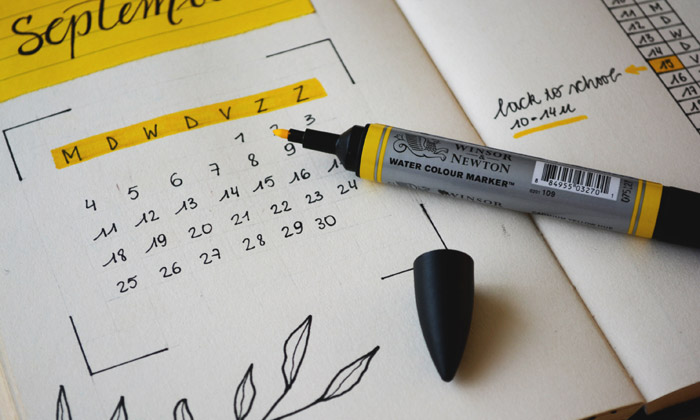It’s party time
Pop quiz: How is a media event like a party? Whether it’s a small dinner party, a wedding for 500 guests, or a news conference, planning is essential for making sure everything runs smoothly when guests arrive. Approach and plan your media event just as you would a party. First, you need your set elements. Once you make these four core decisions, the rest of your planning and preparation will fall into place.
It’s party time! First, choose the:
- TIME: The day of the week, date and time the event will take place.
- PLACE: The event venue or location.
- PEOPLE: Who you want and need at your event. This includes both invitees and the people who will staff and manage the event.
- PLAN: What you want to happen, and the order in which you want it to happen.

Photo by Estée Janssens on Unsplash
TIME
When will the event take place? You’ll want to think about your audience and the optimal time for them to show up for an in-person event. Consider barriers that might limit attendance, such as heavy traffic times, typical work day schedules for attendees, other local events and holidays. You will want to choose the time based on who you want there and when your news or message will be most effective. If the event will be recorded or televised, you need to keep in mind broadcast schedules (e.g., to make the 5pm news, the event probably needs to be in the morning). After you set your date, you will want to determine how far in advance you’ll have to send out invites, press advisories, and press releases. Other things to consider are:
- Most media do not work on weekends.
- Slower news days, like Monday or Tuesday, are better.
- For local news, events should take place in the morning to make it onto the evening broadcast. Between 10 and 11 is best. If TV isn’t a main target you can be more flexible with your timing.
PLACE
Where will the event be held? Think about your location as part of the story you’re trying to tell: what kind of space will allow your group to convey its message the best? Your venue will shape the kind of presentation or conference you give. Make sure you:
- Have enough space for people and equipment. Create a rough site map to determine where those things will go, as well as furniture, podium, signage, and refreshments.
- Find out if you need to rent any extra supplies. This includes tables, chairs, and audio/visual equipment.
- Determine if an audio or visual demonstration is right for your event. Avoid them unless you have a large and public audience. For podium speakers at this kind of event, allow extra time for broadcast and radio reporters to plug into a media line and get access to the audio.
- Determine if your venue is easy to access and where your guests will park. Put up signage to make busy attendees’ lives easier.
- Get permission to use the space you want.

Photo by Andrew Knechel on Unsplash
PEOPLE
Who are the people you want at your event – and who do you need to have there? There are three groups of people to consider: your group’s messengers, your staffing, and the media representatives attending.
MESSENGERS
Chances are, you’re already thinking about what kinds of voices can best share the information you hope to convey at your media event. These may be people from your own organization, or partner groups, or maybe businesspeople or residents of the location you’re showcasing. Those voices – your list of speakers – need to be at the event, so you’ll want to plan timing and location around their availability. Things to consider are:
- The presentation skills of your participants. Effective messengers are clear, concise, and avoid distracting behaviors like “um”-ing or fidgeting.
- Practice time. Allow time for rehearsals so that participants can nail down concise speeches with no more than 3-5 key points.
- Which messengers will tell your story best. Options include:
- Community leaders
- Community residents
- Subject-matter experts (scientists, physicians)
- NGO leaders or staff
- Policymakers or elected officials
Each option has advantages and drawbacks. Subject-matter experts or NGO leaders are articulate and knowledgeable about their topics, but can have trouble connecting meaningfully with broad audiences. Community leaders or residents affected by your issue have powerful firsthand accounts, but may not be practiced communicators.
MEDIA
You also need to be strategic about which media representatives you want at your event. Things to consider are:
- Your organization’s previously established media relationships and how you can leverage them.
- The specific media outlets you want there. National, state or local news outlets should be chosen based on the scope of your issue, who’s affected, and who will be interested. For example: if your message is environment related, invite environmental journalists or writers for environment-focused papers. However, if the environmental issue also has public-health ramifications, outlets with broader audiences may also be interested.
- Which reporters have covered your issue before.
- Whether you’ve made sure to include local outlets that represent smaller communities related to your area or topic.
STAFFING
Create your team. Well-run events typically have a number of people that staff the event and make sure things run smoothly. Decide who from your own team has specific capabilities that you may need, and designate roles with an internal staffing plan in advance. Things to consider are:
- Roles your staff will have. Assign roles like parking attendant, greeter, sign-in, big-wig hand-holder. Who will make sure everyone knows what time to arrive and where to be?
- Assigning someone who knows how to run and troubleshoot audio and visual (A/V) equipment, and capture photo and video as well.
- Your own capabilities and, if you have partner organizations, whether they can pitch in to help with event staffing responsibilities.
GAMEPLAN
It’s not enough to get people there—you need to be thoughtful in how you use their time and make sure that you organize the event to accomplish your goals. Things to consider are:
- Visuals that look and sound interesting to media, to entice them to attend and cover the story.
- Outlining a clear agenda: greeting and sign-in, opening comments, presenting your news/issue, Q&A session. Other possible elements are site-tours or audio or visual presentations. Brevity and keeping to time are key.
- Planning each element in an order that maximizes its effect.
MESSAGE
Just as the right music sets the tone at a party, you’ll want to have a compelling and concise message: no more than three key points is your goal. Make it as easy as possible for reporters to understand what’s most important. Make sure that:
- Your key points are clear and repeated.
- You have rehearsed, coherent answers to questions that can be anticipated, including devil’s-advocate-type questions.
- You’re prepared for a rude Q&A, staying calm and cordial.
- Everyone feels welcome and respected. That means practicing with speakers to avoid jargon-filled responses and patronizing, as well as continuing to bridge back to main messages.
- Your speeches and responses are short; about 3-5 minutes for the former and 1-2 minutes for the latter.

Photo by Pineapple Supply Co. on Unsplash
Task list
BEFORE THE EVENT
4 weeks in advance:
- Reserve and confirm the venue and gain permission to be on the grounds with media (note: more lead time may be needed, depending on the venue).
- Research, compile and write up list of media contacts for a pitch list. Do the same for your guest list—members of the public or VIPs.
- Determine supplies needed: audio/visual, presentation, food, nametags, etc.
- Create and edit sample invites, including VIP invites if applicable.
- Finalize and send out VIP invites.
- If inviting Member(s) of Congress, also consider inviting other Member(s) of Congress from the district, their staff, as well as state and local elected officials.
- Finalize and send out other invites.
- Follow up with phone calls, a few days after the press advisory and then right before your event.
- Determine your agenda: who’s speaking when, presentations, Q&A, etc.
- Prepare press materials and get approvals: press advisory, press release, press kit, promotional material.
- Arrange for capturing photo and video of your event.
1 week before:
- Email press advisory and follow-up calls to priority reporters
- Confirm attendance of elected or other VIPs worth noting on your media advisory (note: people like the mayor or governors usually won’t be able to confirm attendance until the day before; still, list their name on your media advisory and note “invited” so the media knows that they may attend.)
2-3 days before:
- Follow-ups on press advisory: email and calls.
- Rent or acquire your audio/visual equipment.
- Practice or confirm details for setting up audio/visual equipment at your venue.
- Confirm venue arrangements for seating, refreshments, presentation space, sign-in station, etc.
- Arrange press kits, name tags, and other materials to be easily accessible.
- Send or phone-call an event reminder if applicable, and include directions to your venue.
- Finalize details of photo/video capture.
- Rehearse your presentation and practice expected Q & A, including with other speakers if applicable.
- Pack a “supply box” with everything you’ll need to set up: tape, zip ties, clipboard, name tags, markers, extra paper, business cards, etc.
DURING THE EVENT
Now it’s party time!
- Set up signs and directions (laminated if outside in case of rain) in venue, if applicable.
- Meet with AV person early to set up any microphones or A/V equipment as needed.
- Welcome your guests: have them sign in, get nametags and press materials, and show them their seats.
- Make sure you have someone at the door to greet and help latecomers.
- Hold your event, leaving time for questions.
- Have someone capturing images of your event for the duration.
- For longer events, when the audience’s energy wanes, provide that sorely-needed snack break.
- Live tweet or post from your event, including behind-the-scenes photos and close-ups with your VIPs.
AFTER THE EVENT
You made it! Now there are just a few loose ends to tie up.
- Clean up your venue, take down your signs.
- Send thank-you notes to those who attended, particularly the speakers and members of the media.
- Provide follow-up materials and reach out with final press releases to those who did not attend.
- Thank members of your own staff who contributed.
- Pay everyone, if you haven’t already—your audio/visual help, photographer, videographer, caterer, etc.
- Compile, edit, upload and distribute images and videos from your event.
- Promptly respond to requests for follow-up interviews or press materials.
- Write an op-ed to pitch to the local media; write a blog post for your own website and offer it to partners to cross-post as well. Include photos from the event.
Download a PDF copy of this tipsheet here.
